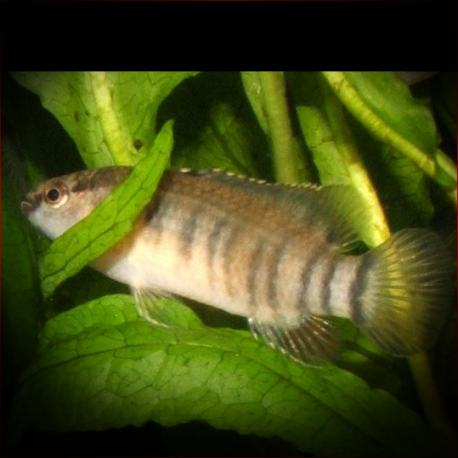More info
Datasheet
| Minimum Tank Size | 60 litres / 15.85 US gallons |
| Maximum Size | 6.0cm / 2.36inches |
| Temperature | 15°C / 59.00°F - 25°C / 77.00°F |
| Hardness | 1.01dgH / 18ppm - 5.04dgH / 90ppm |
| pH | 7.0-9.0 |
Behaviour
Given its rarity in the hobby, emphasis should be on captive reproduction for Badis Kyar. It is recommended to maintain it alone due to its non-gregarious nature, as rival males can exhibit high levels of aggression, especially in smaller tanks. In roomier setups, a group can coexist if there is enough space for each male to establish a territory with plenty of broken lines of sight facilitated by the clever placement of caves across the tank. When considering a community tank, tankmates should be chosen carefully, preferably peaceful species that won't outcompete or intimidate Badis Kyar. It should not be housed with similar-looking, territorial bottom dwellers or other Badis species to prevent hybridization. Freshwater shrimp and their young may be preyed upon.
Feeding and Diet
Badis Kyar is a micropredator, primarily feeding on small aquatic crustaceans, worms, insect larvae, and other zooplankton. It may not readily accept dried foods, so a diet consisting of small live or frozen fare such as Artemia, Daphnia, or bloodworm is recommended to maintain ideal coloration and conditioning. Caution should be exercised with food choices to prevent obesity and susceptibility to diseases.
Reproduction & Dimorphism
Although Badis Kyar has not yet been bred in aquariums due to its rarity, successful breeding strategies for other Badis species involve cave spawning and the formation of temporary pair bonds. Rival males become combative during breeding conditions, displaying courtship behavior towards females within their territories. Post-spawning, the male takes sole responsibility for guarding the eggs and fry. Sexual dimorphism is evident, with males developing elongated fins, more intense coloring, and larger size compared to females.
Habitat and Distribution
Natural Habitat: Found in the shallow, clear water streams of the upper Ayeyarwady River basin in northern Myanmar, Badis Kyar shares its habitat with other species like B. corycaeus and Dario hysginon, each occupying different ecological niches within the stream.
Aquarium Setup
Badis Kyar thrives in a well-structured aquarium setup with a sand or gravel substrate, water-worn rocks, and pebbles for cover. Consider adding attached plant species like Microsorum or Anubias for aesthetics. Driftwood, floating plants, and leaf litter can enhance the natural feel of the tank. Caves are crucial for spawning sites, with options like half-coconut shells or upturned clay plant pots often used by breeders.
(For additional details, refer to the provided information on distribution, behavior, feeding, reproduction & dimorphism strategies, and recommended tank setup for *Badis Kyar*.)

